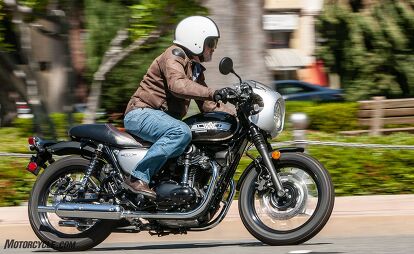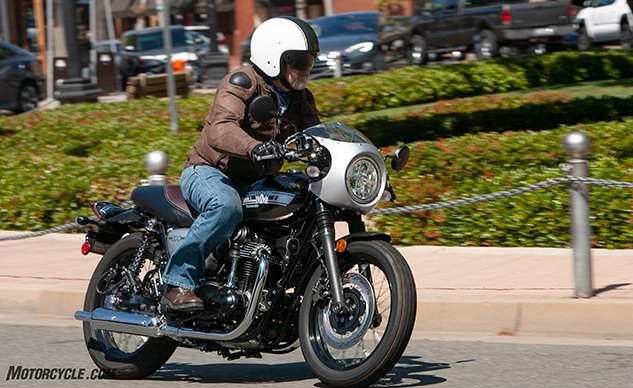2019 Kawasaki W800 Cafe Review
Making "the Ton" Exciting Again!
Oh dear, it’s kind of like one of those deals where you nag a person to do a thing for years, then they do the thing, and you sort of wished you hadn’t encouraged them. Suggesting someone take accordion lessons. Encouraging your wife to take up the krav maga. We always asked Kawasaki why they weren’t cashing in on the “classic bike” market along with the other OEMs, given that they’ve been selling the W800 in other markets since its 2011 upgrade from W650. But now that the W800 is here I kind of agree with their decision not to import it. The W800 is a perfectly nice retro motorcycle, but it’s retro in a way things like Triumph’s “Classics” and some others aren’t: The Kawasaki feels kind of old instead of just looking that way. [Updated with video.]
2019 Kawasaki W800 Cafe
| Engine | 15.0/20 |
| Suspension/Handling | 10.0/15 |
| Transmission/Clutch | 7.0/10 |
| Brakes | 7.0/10 |
| Instruments/Controls | 4.0/5 |
| Ergonomics/Comfort | 8.0/10 |
| Appearance/Quality | 9.0/10 |
| Desirability | 7.0/10 |
| Value | 7.0/10 |
| Overall Score | 74/100 |
Exhibit A would be the Dunlop 300K tires it rides upon. They look like real old-fashioned tires from the ’60s. And they ride just like them on rain-grooved freeways, too. I haven’t been so sketched out since riding that giant BMW Adventure a few weeks ago in deep sand. Squeeze the bike with your knees, hold on lightly and don’t panic even though it feels like you’re riding with a flat tire; you’re probably not on the verge of wiping out (on the BMW, I wiped out a few times just as I’d convinced myself I wasn’t going to; that’ll mess with your psyche). The only reason I didn’t pull over to check tire pressures was because Ryan Adams told me he’d already pulled over to see if something was loose after he’d picked the bike up from Kawasaki, when I picked the bike up at his house.
On non-grooved pavement, the tires are fine, and so is the W. Thanks to the period-correct spoked wheels, the tires also have tubes inside them. Super handy for when you run over the next roofing nail. Be sure your AA policy includes motorcycle assistance.
That parallel Twin engine is actually pretty okay. With its 77 x 83mm undersquare bore and stroke, you’d expect it to be torquey down low – but its torque peak is in fact up at 4700 rpm, so it kind of likes to be revved up more; it really doesn’t wake up till around 4000 rpm. You get your 45.5 hp peak at 6100 rpm – and just when you’re thinking yeah baby, you run into the limiter at 7k. All of that would be alright, too, but the quarter-turn throttle makes you have to grab two handfulls to get to WOT. There’s also quite a bit of your classic parallel-Twin vibration coming through the grips, peaking at around 3500 rpm and 60-or so miles per hour. It’s never the old-fashioned kind that makes you think you’re holding onto a live 220v cable, but it’s there, and it might be enough to put off sensitive types. It’s all just like the ’60s!
After a while, like always, you adjust to the W’s peccadilloes and enjoy it as much as any new motorcycle somebody’s kind enough to loan you. There’s a back way through the hills to the MotoGP Werks’ dyno, and you wind up glad the Kawasaki’s tires strongly suggested you take it instead of the freeway: There are quite a few swoopy curves through hills with fresh wildflowers springing up all along them, and the classic old beast loves burbling through them at 70-ish mph and 4000 rpm singing that classic baritone tune. What’s new pussycat, whoaaa whoaaaa whooooOOOOAA… Kawasaki says the thing is “sound tuned,” and the dual chrome peashooters really do sound period-correct great from idle on up.
With its 360-degree long-stroke crankshaft, lowish compression and real old-fashioned air-cooledness, the W is a more period-correct English Twin than the other English Twins on the market. Its “clubman” handlebar pulls you down into the cockpit a bit more than a Triumph Street Twin, and sighting along the top of its silver half-fairing really does put you in more of a Rod Stewart frame of mind, before Rod got so old.
The riding position feels a little too aggressive when you first climb on, but the foot pegs are far enough forward that your legs take some of the weight off your wrists, and it’s overall really quite comfy even in town. The seat’s thickly padded and no complaints; it’s also narrow up toward the gas tank, and no problem flat-footing the pavement at stops. Speaking of stops, the W draws a crowd of boomers wherever it’s parked. Be prepared to listen to all their stories from the swingin’ ’60s. For a while.
We’re back to that “ride a slow bike fast” thing again: Once you learn to slip the clutch a bit to keep the old analog tach needle up between the big 4 and 7, she scoots right along. The slip/assist clutch works great: At higher rpm you don’t need it for shifts; at lower rpm it’s a pleasure to use as you blip for downshifts in the time-honored way. At lower rpm your shifts are more lugubrious than on a modern classic Triumph, for instance, and it’s not unusual to have to toe the shifter twice to get the gear pairing you want.
The tires’ centers may be sketchy, but their shoulders work much better as you arc the old girl through the curves. The suspenders, a 41mm fork up front and twin bumpsticks out back, are softish in compression, which is nice since the lean forward to the grips has you riding directly through perineum country. Luckily the seat’s nicely padded in that area and the footpegs are just in the right place to carry some of the scrotal freight.
Grabbing the brakes halfway round a corner though, has the fork bobbing right back up from compression – another thing that suggests you ride the way they did in the ’60s: smoothly, and also using the nice rear disc to calm the proceedings. If you do have to stop suddenly, though, it shouldn’t be a big deal. Combining use of the front and rear ABS-equipped discs will howl the W right down to a quick halt. What’s the word the kids use now? Mindfully. It’s not a point and shoot motorcycle, it’s one for motoring, just like my old XJ6 Jaguar. It’s a saloon, and not the kind you drink beer in.
Taken all together – the softness and slight lack of rebound damping, deliberate steering, the old-timey tires, lack of low-rpm power, the not-svelte 501-pound weight of the thing – the W sort of reminds you why doing the Ton (100 mph) was such a big deal once upon a time. The W will get you there eventually, but then you kind of wonder why you wanted it to? Especially if you then hit a stretch of rain-grooved pavement.
The coolest part of the bike for me, the thing that could redeem it, is its bevel-gear cam drive, that cool chrome column on the right side of the engine just like on an old Ducati!
Shirley somebody makes one of those glass covers you can put on there to watch those cool gears mesh and fling oil? When you take that round cover off the Kawasaki engine to behold that mechanical magic, though, all you see is another cam cover. If you want to watch those gears, well, you can’t. Cruel hoax. What’s the point?
The point is the W650 appeared before any of the current Triumph classics, and while it’s cool Kawasaki bumped it up to an 800 in 2011, they haven’t really done much else to bring it into the 21st century. Some buyers might like that? As for us, Triumph Speed Twins and Street Twins and things look old but ride completely modern in terms of their drivetrains, suspensions, everything. And that’s what we MOrons have come to expect now when we see a motorcycle that looks as cool as the W.
Lastly, we hate to bring up the $9,799-ness of the thing, but that’s a bit more than Triumph wants for its original Street Twin ($9,100) and New Street Twin ($9,300), both of which are more powerful, lighter and better- suspended than the W. And go ahead and try to pay no attention to the also superior Royal Enfield Continental GT we’ve been riding around on: $6,249. Granted, the Triumph Speed Twin is more expensive, but that bike is so far removed from antiquity it’s almost in a different class than the W800.
If what you crave is a bike that really does feel, sound and ride like the old BSA that Kawasaki copied with the original W1 in 1966, the W800 is the only game in town, and as close as you’re going to get in a brand-new motorcycle that’ll do everything those bikes did, almost literally, except leak oil and leave you stranded. Don’t take all the critical things we just said to mean we don’t love the W; it’s still one of God’s children. Just probably not His favorite one.
2019 Kawasaki W800 Cafe
+ Highs
- More classically British than modern British classics
- Love the round instruments and bullet fairing
- More comfy than you’d expect at first sit
– Sighs
- We’re kind of spoiled by newer “classics” that only look vintage
- Not exactly a powerhouse and not exactly light
- I want to see the bevel drive driving dammit
In Gear

Helmet: Shoei JO $449
- Jacket: Dainese Street Rider Perf discontinued
- Jeans: Alpinestars Tech Denim Ablaze discontinued
- Gloves: Reax Superfly Mesh $69
Boots: Dainese 36060 discontinued
2019 Kawasaki W800 Cafe Specifications | |
|---|---|
| MSRP | $9,799 |
| Engine Type | 4-Stroke, Air-Cooled, SOHC, 4-Valve Cylinder Head, Vertical-Twin |
| Displacement | 773 cc |
| Bore and Stroke | 77.0 x 83.0 mm |
| Maximum Torque | 46.4 lb-ft. at 4800 rpm (claimed) |
| Compression Ratio | N/A |
| Fuel Injection | DFI with Dual 34mm Keihin Throttle Bodies (2) |
| Ignition | TCBI with Digital Advance |
| Transmission | 5-Speed with Positive Neutral Finder |
| Final Drive | Sealed Chain |
| Front Suspension | 41mm hydraulic telescopic fork, 5.1 inches of travel |
| Rear Suspension | Dual shock with ajustable preLoad, 4.2 inches of travel |
| Front Tire | 100/90-18M/C 56H |
| Rear Tire | 130/80-18M/C 66H |
| Front Brake | Single 320mm Disc with 2-Piston Caliper, ABS |
| Rear Brake | Single 270mm disc with 2-piston caliper, ABS |
| Rake/Trail | 26.0°/3.7 in |
| Wheelbase | 57.7 inches |
| Fuel Capacity | 4.0 gallons |
| Seat Height | 31.1 inches |
| Curb Weight | 489.5 pounds/501 pounds for California models (claimed) |
| Colors | Metallic Magnesium Gray/Galaxy Silver |
| Warranty | 12 months |
More by John Burns





















































Comments
Join the conversation
No, there are currently no glass windows for the cam drive and stop calling me Shirley.
Is there a fuel shut off valve?